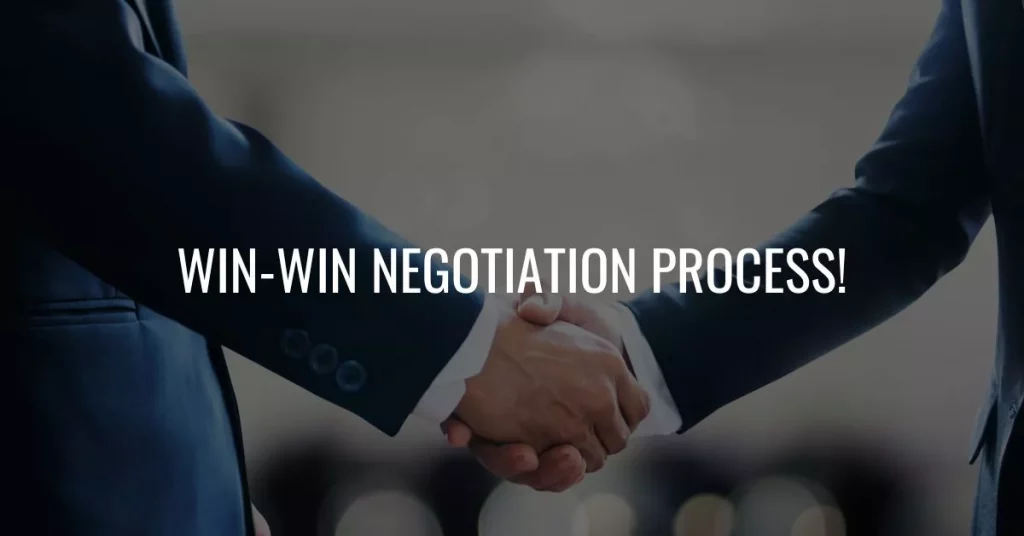Win-Win Negotiation Process!
Consider you have an issue with another person. Is your first instinct as a manager to take any action or you will try to make a negotiation session with the other party to find acceptable solutions for that issue?
Great managers use a win-win negotiation process to find solutions when what they won’t conflict with what the others won’t, and they try to find solutions that are acceptable to the two parties and try to find solutions where the two parties are satisfied and feel that they have won.
If the other person has the power all the time and doesn’t care about you and about your objectives and you don’t have any power, no doubt that you will lose something; the negotiation, in that case, is also helpful to reduce the losses.

Win-win negotiation importance:
There are many benefits of using a win-win negotiation process such as:
- The relationship between the people is maintained because the win-win negotiation process separates the people from the problem and disallows the situation to damage the relationship between the people because the win-win negotiation depends on resolving the issues, not the personals affront.
- The process allows to people to generate more options to resolve the situations and prevents or reduces the losses of any issue.
- To improves your listening skills and understand how people think, it’s a good opportunity to do that by discussing the other party and listening to his point of view.
Preparing for a successful win-win negotiation process:
Before starting a negotiation you should think about the following points to make a successful win-win negotiation session:
- Goals: it’s to think about what you want to get out after the negotiation, and think about what the other person wants to get out also.
- Trades: it’s to think about what you can introduce for the others, and what the others can introduce for you.
- Alternatives: think about what if you will not reach an agreement with the others. What will you lose? And what are the available alternatives that the other person has?
- Relationship: think about how the relationship between you and the other person is, and how will the relationship be if the other person isn’t satisfied after the negotiation? And keep in mind that win-win negotiation enhances the relationship significantly.
- Expected outcomes: think about what are the outcomes that are expected by you and by the other person? And what were the expected outcomes in the past?
- The consequences: think about what are the consequences for you of losing or winning after the negotiation? And what are the consequences for the other person?
- Possible solutions: what are the possible solutions to achieve a win-win agreement, and what are the possible compromises without achieving a win-win agreement.
- Power: think about what is the power the other person has? Who has more power? Who will lose if the two parties failed to reach an agreement? And does the other person control what you hope?
The win-win negotiation is more suitable and easier when being between two persons who have the same power or the same position.
Win-win negotiation process
To get a successful negotiation session, you should have clear steps and know what you will do; in the following points we will clarify how to get a successful negotiation session:
Setting negotiation plan:
After the preparing for the negotiation as mentioned above, it’s the time to set your plan as follows:
- Determine your objectives and the other person’s objectives: what is the minimum outcome? What is the anticipated outcome? And what is the ideal outcome?
- Determine the concessions you might make.
- Determine what you will do if the negotiation succeeds or fails.
- Collect any needed information to get a successful negotiation session such as:
- Will your objectives conflict with the other party’s objectives?
- What are the benefits to the other party if you achieve your objectives?
- Try to find any shared objectives to get a successful negotiation process.
- Try to find a big deal if the other party has a big authority.
- Try to set solutions for any conflict between the objectives.
- Set a time and place and be ready for your negotiation session.
Start the negotiation session:
After setting your time and place, it’s the time to start the negotiation:
- Introduce yourself and be confident and demonstrate to the other person that you know what you are doing.
- The other person should feel positive about the negotiation so tell him that you and he/she must be satisfied, and you aim to get a win-win agreement.
- Identify what you need and what your objectives are, then let the other person identify what he/she needs and what his/her objectives are.
- List with the other person what the objectives are accepted, and what the objectives are not acceptable to both of you.
- Tell the other party your suggested solutions for unaligned objectives and ask the other party to tell you his/her suggested solutions for those objectives.
- Try to strengthen your objective that the other person doesn’t want, and try to weaken the objectives that aren’t acceptable to you.
- Try to tell the other person why your objectives are important for you, and how those objectives will not affect his objectives.
- Be ready to make concessions if it’s required and ask the other party to make some concessions to get a good agreement accepted by all parties.
- During the negotiation, the session uses the “take and give” manner to get an acceptable agreement.
- When the other person uses his power and doesn’t care about you, it’s the time to offer your big deal and try to not lose.
Closing the negotiation session
It’s very important to have a formal agreement to be sure that the issue is resolved. So after setting accepted solutions, it’s time to close the session by formalizing the agreement may be by a contract or by a signed copy of the agreement.

Patrick is a lifelong learner and personal development blogger whose work focuses on mindset shifts, emotional growth, and the hard-won lessons from real-life challenges.
Qualities: Relatable, honest, introspective, growth-oriented.
